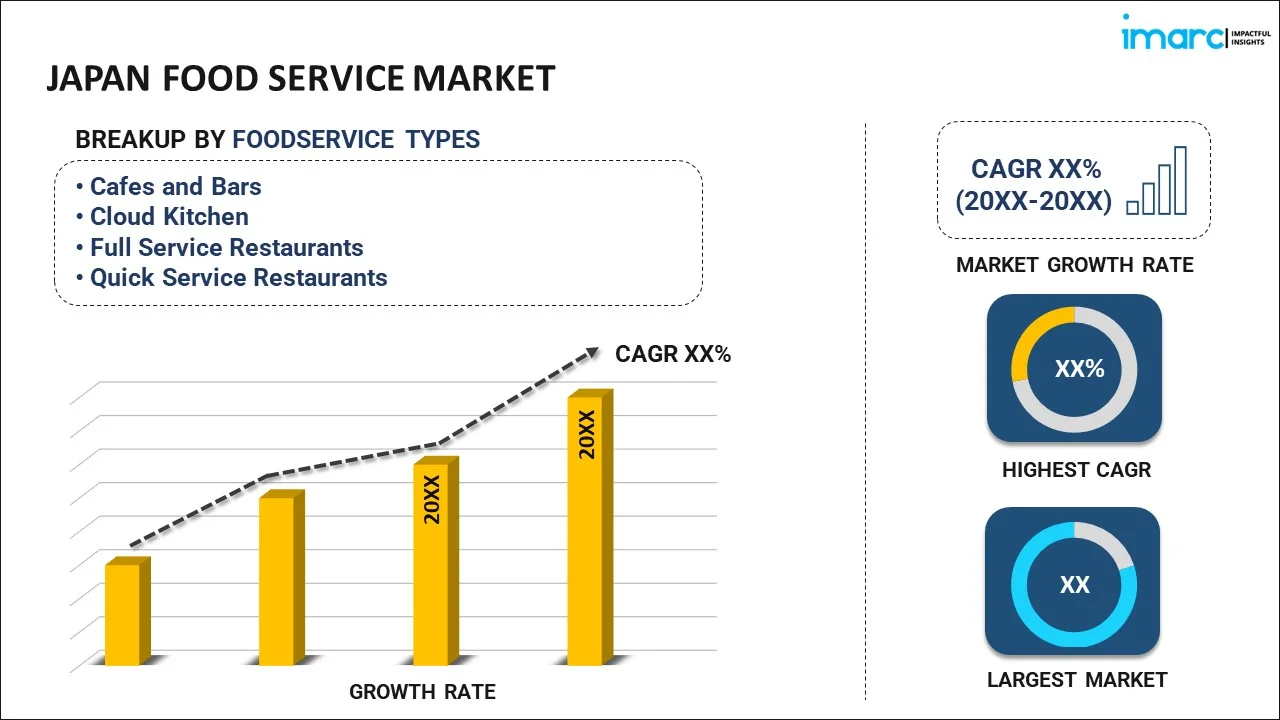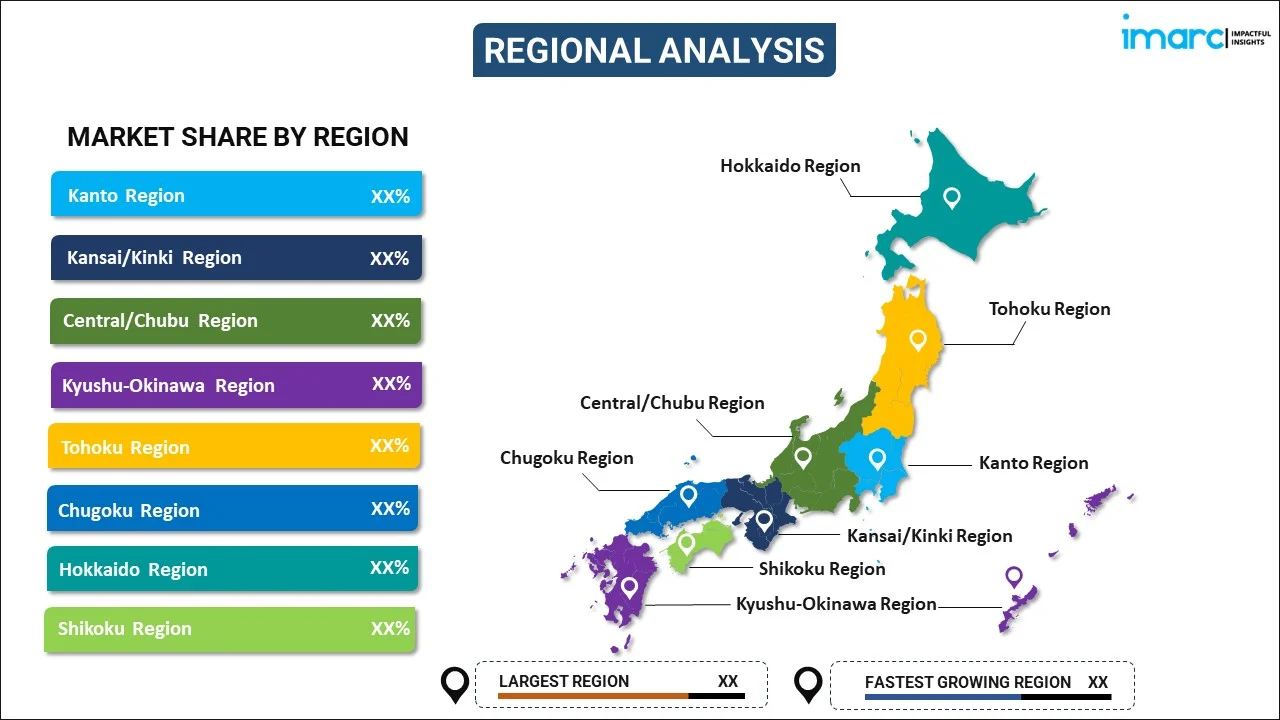
Japan Food Service Market Report by Foodservice Type (Cafes and Bars, Cloud Kitchen, Full Service Restaurants, Quick Service Restaurants), Outlet (Chained Outlets, Independent Outlets), Location (Leisure, Lodging, Retail, Standalone, Travel), and Region 2024-2032
Market Overview:
Japan food service market size is projected to exhibit a growth rate (CAGR) of 10.29% during 2024-2032. The increasing utilization of technology, including online ordering, delivery apps, and digital payment systems, that has transformed the food service industry and created new opportunities for operators to reach customers, is primarily driving the market.
|
Report Attribute
|
Key Statistics
|
|---|---|
|
Base Year
|
2023 |
|
Forecast Years
|
2024-2032
|
|
Historical Years
|
2018-2023
|
| Market Growth Rate (2024-2032) | 10.29% |
Food service refers to the industry and practice of preparing, presenting, and distributing food and beverages to customers. It encompasses a wide range of establishments, from restaurants and cafes to catering companies, food trucks, and school cafeterias. The primary goal of food service is to provide nourishment and culinary experiences to consumers, whether they are dining in, taking out, or having meals delivered. Food service has evolved significantly to accommodate changing consumer preferences and lifestyles. It involves not only cooking and serving food but also managing various aspects like menu planning, food safety, customer service, and restaurant operations. Many food service businesses focus on delivering high-quality cuisine, emphasizing flavors, presentation, and dietary preferences to meet the diverse needs of their clientele. Food service plays a vital role in the economy, contributing to job creation and generating significant revenue. It reflects cultural diversity and innovation in culinary arts, making it an integral part of daily life for people.
Japan Food Service Market Trends:
The food service market in Japan is experiencing robust growth, primarily driven by several key factors. Firstly, changing consumer preferences and lifestyles have significantly influenced the market's trajectory. As consumers increasingly seek convenience and variety, the demand for food services, such as quick-service restaurants and food delivery, has surged. Moreover, rising urbanization and a growing number of dual-income households have boosted the need for dining-out options, further propelling market expansion. Furthermore, technological advancements play a pivotal role in shaping the food service industry. The integration of digital ordering platforms and mobile applications has revolutionized the way customers interact with food service providers, making ordering and delivery more efficient and accessible. This technological evolution has not only enhanced customer experience but also streamlined operations for businesses. In addition to this, the growing emphasis on sustainability and health-conscious choices, as consumers are increasingly seeking healthier and environmentally responsible food options, which push restaurants to adapt their menus and sourcing practices, accordingly, is expected to drive the food service market in Japan.
Japan Food Service Market Segmentation:
IMARC Group provides an analysis of the key trends in each segment of the market, along with forecasts at the country level for 2024-2032. Our report has categorized the market based on foodservice type, outlet, and location.
Foodservice Type Insights:

- Cafes and Bars
- Bars and Pubs
- Cafes
- Juice/Smoothie/Desserts Bars
- Specialist Coffee and Tea Shops
- Cloud Kitchen
- Full Service Restaurants
- Asian
- European
- Latin American
- Middle Eastern
- North American
- Others
- Quick Service Restaurants
- Bakeries
- Burger
- Ice Cream
- Meat-based Cuisines
- Pizza
- Others
The report has provided a detailed breakup and analysis of the market based on the foodservice type. This includes cafes and bars (bars and pubs, cafes, juice/smoothie/desserts bars, and specialist coffee and tea shops), cloud kitchen, full service restaurants (Asian, European, Latin American, Middle Eastern, North American, and others), and quick service restaurants (bakeries, burger, ice cream, meat-based cuisines, pizza, and others).
Outlet Insights:
- Chained Outlets
- Independent Outlets
A detailed breakup and analysis of the market based on the outlet have also been provided in the report. This includes chained outlets and independent outlets.
Location Insights:
- Leisure
- Lodging
- Retail
- Standalone
- Travel
The report has provided a detailed breakup and analysis of the market based on the location. This includes leisure, lodging, retail, standalone, and travel.
Regional Insights:

- Kanto Region
- Kansai/Kinki Region
- Central/ Chubu Region
- Kyushu-Okinawa Region
- Tohoku Region
- Chugoku Region
- Hokkaido Region
- Shikoku Region
The report has also provided a comprehensive analysis of all the major regional markets, which include Kanto Region, Kansai/Kinki Region, Central/ Chubu Region, Kyushu-Okinawa Region, Tohoku Region, Chugoku Region, Hokkaido Region, and Shikoku Region.
Competitive Landscape:
The market research report has also provided a comprehensive analysis of the competitive landscape in the market. Competitive analysis such as market structure, key player positioning, top winning strategies, competitive dashboard, and company evaluation quadrant has been covered in the report. Also, detailed profiles of all major companies have been provided. Some of the key players include:
- Colowide Co., Ltd.
- Food & Life Companies Ltd.
- Kura Sushi Inc.
- Lotteria Co., Ltd.
- McDonald’s Holdings Company (Japan), Ltd.
- MOS Food Services Inc.
- Plenus Company Limited
- Seven & i Holdings Co., Ltd.
- Skylark Holdings Co. Ltd
- Toridoll Holdings Corporation
- Yoshinoya Holdings Co. Ltd
- Zensho Holdings
(Please note that this is only a partial list of the key players, and the complete list is provided in the report.)
Japan Food Service Market Report Coverage:
| Report Features | Details |
|---|---|
| Base Year of the Analysis | 2023 |
| Historical Period | 2018-2023 |
| Forecast Period | 2024-2032 |
| Units | US$ Million |
| Scope of the Report | Exploration of Historical and Forecast Trends, Industry Catalysts and Challenges, Segment-Wise Historical and Predictive Market Assessment:
|
| Foodservice Types Covered |
|
| Outlets Covered | Chained Outlets, Independent Outlets |
| Locations Covered | Leisure, Lodging, Retail, Standalone, Travel |
| Regions Covered | Kanto Region, Kansai/Kinki Region, Central/ Chubu Region, Kyushu-Okinawa Region, Tohoku Region, Chugoku Region, Hokkaido Region, Shikoku Region |
| Companies Covered | Colowide Co., Ltd., Food & Life Companies Ltd., Kura Sushi Inc., Lotteria Co., Ltd., McDonald’s Holdings Company (Japan), Ltd., MOS Food Services Inc., Plenus Company Limited, Seven & i Holdings Co., Ltd., Skylark Holdings Co. Ltd, Toridoll Holdings Corporation, Yoshinoya Holdings Co. Ltd, Zensho Holdings, etc. (Please note that this is only a partial list of the key players, and the complete list is provided in the report.) |
| Customization Scope | 10% Free Customization |
| Report Price and Purchase Option | Single User License: US$ 3699 Five User License: US$ 4699 Corporate License: US$ 5699 |
| Post-Sale Analyst Support | 10-12 Weeks |
| Delivery Format | PDF and Excel through Email (We can also provide the editable version of the report in PPT/Word format on special request) |
Key Questions Answered in This Report:
- How has the Japan food service market performed so far and how will it perform in the coming years?
- What has been the impact of COVID-19 on the Japan food service market?
- What is the breakup of the Japan food service market on the basis of foodservice type?
- What is the breakup of the Japan food service market on the basis of outlet?
- What is the breakup of the Japan food service market on the basis of location?
- What are the various stages in the value chain of the Japan food service market?
- What are the key driving factors and challenges in the Japan food service?
- What is the structure of the Japan food service market and who are the key players?
- What is the degree of competition in the Japan food service market?
Key Benefits for Stakeholders:
- IMARC’s industry report offers a comprehensive quantitative analysis of various market segments, historical and current market trends, market forecasts, and dynamics of the Japan food service market from 2018-2032.
- The research report provides the latest information on the market drivers, challenges, and opportunities in the Japan food service market.
- Porter's five forces analysis assist stakeholders in assessing the impact of new entrants, competitive rivalry, supplier power, buyer power, and the threat of substitution. It helps stakeholders to analyze the level of competition within the Japan food service industry and its attractiveness.
- Competitive landscape allows stakeholders to understand their competitive environment and provides an insight into the current positions of key players in the market.
Need more help?
- Speak to our experienced analysts for insights on the current market scenarios.
- Include additional segments and countries to customize the report as per your requirement.
- Gain an unparalleled competitive advantage in your domain by understanding how to utilize the report and positively impacting your operations and revenue.
- For further assistance, please connect with our analysts.
 Inquire Before Buying
Inquire Before Buying
 Speak to an Analyst
Speak to an Analyst
 Request Brochure
Request Brochure
 Request Customization
Request Customization




.webp)




.webp)












